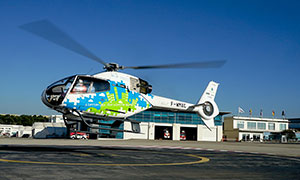
Airbus Helicopters Starts Flight Tests with High-Compression Engine for Cleaner, More Efficient and Higher-Performance Rotorcraft

 Airbus Helicopters successfully completes the first flight test of its high-compression engine demonstrator aircraft at Marignane Airport. The development and flight test of this new technology demonstrator is part of the European Clean Sky initiative’s Green Rotorcraft Integrated Technology Demonstrator (ITD) program, with support for these flight tests provided by the consortium of TEOS Powertrain Engineering and Austro Engine GmbH.
Airbus Helicopters successfully completes the first flight test of its high-compression engine demonstrator aircraft at Marignane Airport. The development and flight test of this new technology demonstrator is part of the European Clean Sky initiative’s Green Rotorcraft Integrated Technology Demonstrator (ITD) program, with support for these flight tests provided by the consortium of TEOS Powertrain Engineering and Austro Engine GmbH.
“The first result of the 30-minute flight confirms the advantages of new-technology, high-compression piston engines for rotorcraft in offering reduced emissions; up to 50% lower fuel consumption, depending on duty cycle, nearly doubled range and enhanced operations in hot and high conditions," says Tomasz Krysinski, head of Research and Innovation at Airbus Helicopters.
In addition to confirming improvements in eco-efficiency, Airbus Helicopters’ in-flight evaluations in the upcoming months will also focus on the right power-to-weight ratios that would make high-compression engines sustainable alternatives to the turbine powerplants typically used in the helicopter industry. The flight test campaign will establish the engine installation at Technology Readiness Level 6 (TRL 6).
Integrated into an H120, the 4.6-liter high-compression piston engine incorporates numerous technologies already applied on advanced self-ignition engines and runs on the widely-available kerosene fuel used in aviation engines. Its V8 design has the two sets of cylinders oriented at a 90 degree angle to each other, with a high-pressure (1800 bar) common-rail direct injection and one turbocharger per cylinder bank.
Other features include fully-machined aluminum blocks and titanium connecting rods, pistons and liners made of steel, liquid-cooling and a dry sump management method for the lubricating motor oil as used on aerobatic aircraft and race cars.
The Green Rotorcraft ITD program that supports the Airbus Helicopters’ research project is part of the Clean Sky Joint Technology Initiative, a European aeronautical research program. Clean Sky’s goal is to develop breakthrough technologies that significantly increase environmental performance of the air transport sector, resulting in quieter and more fuel efficient aircraft and rotorcraft. Environmental targets of Clean Sky are to reduce specific fuel consumption by 30 percent, CO2 emissions by 40 percent and NOx by 53 percent.
Airbus Helicopters’ high-compression piston engine activity began in 2011, followed by company bench tests and system simulations, including successful Iron Bird tests in February 2014. Ground runs with the H120-equipped helicopter were performed during February and March of this year, leading to the first flight.
